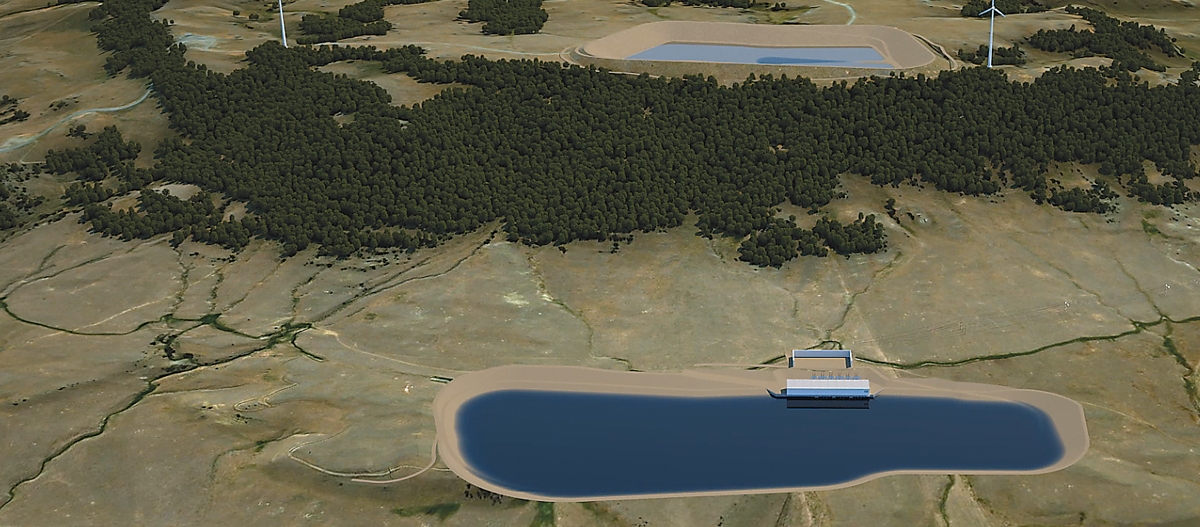Dotting Montana’s landscape, wind turbines and solar panels provide clean, renewable energy. These renewable energy resources are part of the solution to providing carbon free electricity, but Montanans recognize that when the wind doesn’t blow, and the sun doesn’t shine, renewable energy isn’t available. Methods are needed for storing energy that can be used when demand exceeds supply. Chemical battery storage technologies have improved but suffer from degradation that renders them costly in the long run.
The people at Absaroka Energy in Bozeman, Mont., are in the process of developing a “hydro battery” that makes renewable energy more balanced, reliable, and cost-effective.
What Is It?
A pumped storage hydro facility is essentially a water battery that stores and disperses energy, depending on the needs of the electrical grid. When electricity production is high, like on windy days, the water is pumped uphill into an upper reservoir. Then when the wind stops blowing and electricity is needed, gravity surges the water downward and forces it through turbines that turn and generate electricity. The generated electricity is sent onto the electrical grid to maintain consistency and to meet demand.
Development
“I am a lawyer by profession, and in 2010 a client asked me to assist with wind energy development,” said Carl Borgquist, president and CEO of Absaroka Energy. “I realized that with increased utilization of renewable generation, storage and capacity would be essential.”
Borgquist found a new generation of pumped storage hydro facilities had been build in Europe and was being built in China. These units were designed as a shock absorber for grids using renewable energy.
With development of wind energy in Montana, Borgquist felt the state was an ideal location for this new generation of pumped storage hydro equipment.
Initially, Borgquist analyzed the feasibility of using the Berkeley Pit for a pumped storage hydro unit, but the Pit didn’t possess the required environmental and geologic attributes. Pumped storage hydro units need to be located near high-volume transmission lines, with adequate water availability, and on land with a thousand feet of elevation difference within a short distance between two reservoirs. He found the that the 400-acre Gordon Butte site three miles west of Martinsdale, Mont., had all of the needed features.
Operation
Gordon Butte was formed from volcanic activity and has a steep incline with a relatively flat top. Cottonwood Creek, which is a Musselshell River tributary, flows nearby. Through irrigation causeways, creek water will fill the lower reservoir.
Nearby transmission lines transport electricity to the three 135 megawatts (MW) pumps during peak wind production or whenever there is excess electricity on the grid. Neighboring transmission lines function at nearly full capacity, but with two Colstrip units closing down, room for additional transmission will be available. Conveniently, the transmission lines are within six miles of Gordon Butte.
During periods of slow or non-existent renewable energy output, water stored in the 4,000 acre-foot upper reservoir will surge through a pipe down the side of the thousand-foot butte with increasing speed, flow through three 135 MW turbines, and produce electricity. The Gordon Butte facility is designed to discharge water and produce 400 MW of electricity for 8.5 hours. It will take 10 hours to recharge by pumping water back into the upper reservoir.
Putting It All Together
Borgquist found Copenhagen Infrastructure Partners of Denmark, an experienced group of renewable energy bankers who like good clean projects, to assist in financing. “It is an honor to have them involved,” said Borgquist.
Absaroka Energy has also acquired water rights to fill the project reservoir, voluntarily restricting use to runoff in Cottonwood Creek. It will take approximately 35 days initially to fill the lower reservoir. Due to evaporation, additional water will be added to replenish what was lost, which will take only two or three days.
Borgquist maintains a relationship with the Public Service Commissions in the Northwest States to keep them informed. He also has to sell the electricity produced at the pumped storage hydro facility. For that he is working with large commercial end-users who will become customers. The project will cost approximately $5 million a year to operate, maintain, and produce hundreds of millions of dollars in revenue, resulting in a large tax benefit to state and local governments.
Black and Veatch, a worldwide firm with energy development and distribution experience, will do the engineering; General Electric will build the equipment; and Ames and Dick Anderson Construction will construct the project. As many as 300 to 400 workers will be needed during the estimated four-year construction period to build the project, which will cost close to a billion dollars. Anywhere from 20 to 24 employees will be needed to operate Gordon Butte Pumped Storage Hydro Facility once construction is completed.
Impact
“As the largest, privately funded infrastructure project in Montana’s history, work on the Gordon Butte Pumped Storage Hydro Facility is projected to begin in 2020. The economic impact on Montana will be enormous,” said Borgquist. MSN












